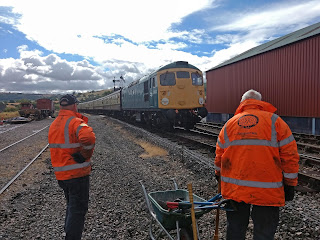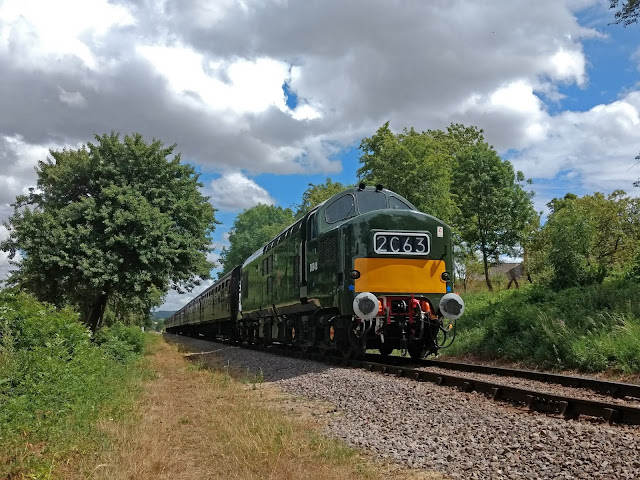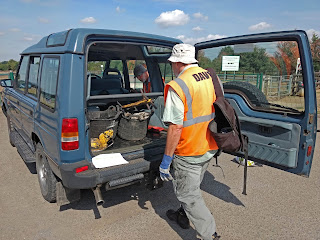Out first job of the day was to quickly replace a timber in the turnout main-line-to-C&W-sidings.
We were disturbed in our doings by the class 26 trundling into Winchcombe.
Then it was back to the business in hand. This timber was found to have a hole burned into it, so had to go.
Luckily this was withing the yard, only a short walk from where we had stored a replacement. It came out easily enough; then a replacement was pulled in using the nips.
There was quite a frenzy of loco activity this morning, as almost immediately after the class 26 arriving, the Peak left the other way, heading for Toddington. starting at Winchcombe, don't see that very often.
As soon as Toddy box accepted it, they let go the blue class 37.
It's all fun for the diesel supporters, and we saw quite a few of them today. It's nice to ring the changes.
You can see all the afficionados on the end of the platform here, having detrained from the DMU hauled by the class 73. That has to be a strange combination.
Then of course the class 73 left.
Our gang today was small, and it's no wonder - Dave here is second manning the diesel for example.
Come on, how about wielding a shovel down here with us?
Another member of the PWay gang was spotted on the cushions, two days running! That's very keen.
Notice Neil leaning on the Landie, and the Landie leaning back. Incomprehensible, Neal was on salad rations at lunch too. Our money is on a suspension issue with the Landie...
Finally we had a half hour window and used this to drill and bolt up the replacement timber. We packed it, backfilled it, and it was - Job Done !
As we were packing up our visiting Warship arrived.
'ONSLAUGHT' rolled into Winchcombe, past a considerable bank of photographers, stationed in an arc from one platform end to another, even peeping out from a gap next to the signal box. Diesel fans also had the opportunity to wander down to the far end of the C&W shed, where an area for them had been prepared. This gave an excellent vantage point for them.
The arrival of the Warship released the road for the class 26 to continue on to Toddington, seen here across the PWay yard with the C&W sheds in the background.
We then retired for a breather and a light lunch. That's what we tell our wives, who don't know about Mr. B's cakes. Vanilla and chocolate fairy cakes today; we sent the box back empty to the bakery.
After lunch we addressed a second issue, this time at Stanley Pontlarge. A small village alongside our railway, with an interesting name. Stanley refers to a stony clearing or field, and Pontlarge refers to the origin of the people that owned it - Pont de L'Arche in Normandy. Not a lot of people know that.
(and it wasn't Michael Cane BTW who coined this phrase, but Peter Sellers)
Here we are on an interminable straight between the tunnel mouth at Greet and the big cutting at Dixton. A twist had been reported here, and we came to see for ourselves, and perhaps even fix it straight away.
The arrival of visitor D7017 gave us an opportunity to observe the behaviour of the track, and indeed the train above it. The problem wasn't so obvious with this method however, as there was a temporary speed restriction so the train just casually trundled over the problem at 10 mph.
Plan B was less practical but more scientific - get the track gauge out and measure everything.
This revealed that there was indeed a height difference for a short stretch, which would give the twisting effect reported by the loco crews.
Of course there is another way of checking the levels, old but always reliable - put your eye on the rail and look along it.
The two measurements gave Nigel all the information he needed, and devise the measures required to take the twist out.
The Green Goddess D6948 also paid us a visit. What a magnificent locomotive, here in the Cotswolds countryside. No wonder people come to our diesel gala.
You might wonder why it is that in the middle of this long straight, in reasonably good condition, the track now has a twist in this precise spot.
We think the answer lies in this small group of 2 - 3 trees, which have been allowed to grow very close to the track. Their roots, which extend as far out as the canopy above is wide, influence the water content of the trackbed under the rails. You can also observe some slight abnormalities in the straightness of the rails, also caused by movements below ground.
Having worked out the exact location and extent of the twist, we dug out all the sleeper cribs along the lower side, jacked the track up with the 4 pan jacks you can see in this picture, and then re-packed the ballast under the sleepers.
We then waited for the next train and watched what the track did underneath it. The answer of course was nothing, just what we expected. Satisfied with our lift and packing, we back filled everything again and moved on to the next bit, just a couple of yards away.
This was a noticeable dip in a joint, a common feature with second hand rail such as ours. This too we dug out, lifted and packed. The track here was laid in about 1991 on chaired concrete sleepers and bullhead rail, a relatively rare combination these days. You need to keep up to speed with track components, because the big railway continues to evolve and there comes a point when you find that spare parts for your bits of track (eg SHC clips) are no longer manufactured.
Here's our last PWay shot of the day, taken as the Landie returned along the other side of the former double track bed back to the point of entry, Gotherington Skew bridge.
It's taken at 3 arch bridge, well known to photographers, but not from this angle. Enjoy !
Broadway snippets.
Already reported on the S&T blog but without a shot of the end of day result, here is a picture of the space created between two lamp posts following the removal of about a quarter of the concrete ducting that has been stored on P2 at Broadway for quite a while now.
The grass (in fact sown by your blogger) can now regrow in this area, and more piles of troughs will be removed as opportunity permits. Now to find a way of removing the remaining platform copers - they are heavy!
Down below, work has started on the car park - great stuff.
The first job is to remove a top layer of about a foot. This will be replaced by fresh stone. The two ends of the site will be tarmacked, while the middle (the majority of the surface) will be open blocks of stone that allow surface water to drain through, so minimising the impact on the Broadway brook at the far end.
From above you can see the 360 digger slowly working its way down, with site huts in the foreground. The footpath is closed for the duration.
On completion of the works, access to our trackbed via the steep slope will be maintained.
Friday is normally a non-running day, but this time the day was included in our three day diesel gala programme.
 |
| The class 26 was the first train of the day. |
Next came the class 20 with its train made up out of the DMU.
We were pleased to note that it was chokka, never seen the DMU that full before.
Work for today centered around the installation of the replica fireplace. Don't get too excited yet, it isn't finished, so everything you see in pace is just a trial fitting. It'll probably go in finally next week.
Here Neal is creating a groove down one side. This will receive the side of one of the uprights, and with a dose of plaster will hold it in place. The insert has been put in its future place so that we can measure up.
With the groove cut out, Neal was able to test its position and depth with one of the new slate uprights. Behind him is the hearth, still wrapped up.
More rumblings outside - what is it this time? Ah, it's the green Growler easing itself into the station.
Back inside, Neal has cut the second groove, on the opposite side, and here are both uprights being trial fitted. There's still the panel across the top to go, but we have that too.
Starting to look like it now, with that top panel fitted. If you contributed to the funding for this little gem, give yourself a little pat on the back. Just look what we are achieving !
The mantlepiece will go across the top, but due to its delicate nature, it is still off site until the last moment. It is a solid piece of slate, with a lovely beveled edge to it.
It strikes us that, having seen one in a different refreshment room, a clock would not look out of place higher up on this chimney breast. It would need to look like the one in the booking office, and its function would be to remind passengers when their train was due to leave.
Outside again, our visitor D7017 has arrived. What an interesting locomotive, with a completely different engine sound, almost purring. Look how it compares to the class 26 that came in a couple of hours earlier:
Class 26 Hymek
Cylinders 6 in line V 16
Horsepower 1160 HP @750rpm 1700 HP @ 1500rpm
Displacement 133 Litres 86 Litres
If you'd like to hear it leave Broadway at the head of this train, you can click on this YouTube link:
https://youtu.be/bKXGsWYRy4Y
To compare the style of engine, try this one of a class 25 on the NYMR. They had the same Sulzer 6 cyl in-line engine as our class 26:
https://youtu.be/N-06yjoLkGU
Meanwhile, back to the fireplace. As we said earlier, it consists of 3 parts, slate surround, cast iron insert (with slate panels) and slate hearth.
We have a brand new hearth made for it, which Neal here is trimming at the corners to make it fit under the insert.
And here is the slate hearth, in its trial fit in front of the fireplace cut out. It has a lovely smooth finish to it. We also have the original steel hearth surround for it, found buried on site and restored. It will rest on top of the hearth, with its ends touching the two uprights.
Nearer the end of the day, a quick peek to see how the car park contractor was getting on.
You can see clearly now how the top layer is being scraped off.
Another small job done on Friday was touching up the GWR trespass notice (the 40 shillings one) prior to fitting to its post.
Here it is, going on. Everything GWR - except for the security camera on the canopy end. Fingers crossed that there are no other plans to disfigure the 1904 heritage canopy.






























































